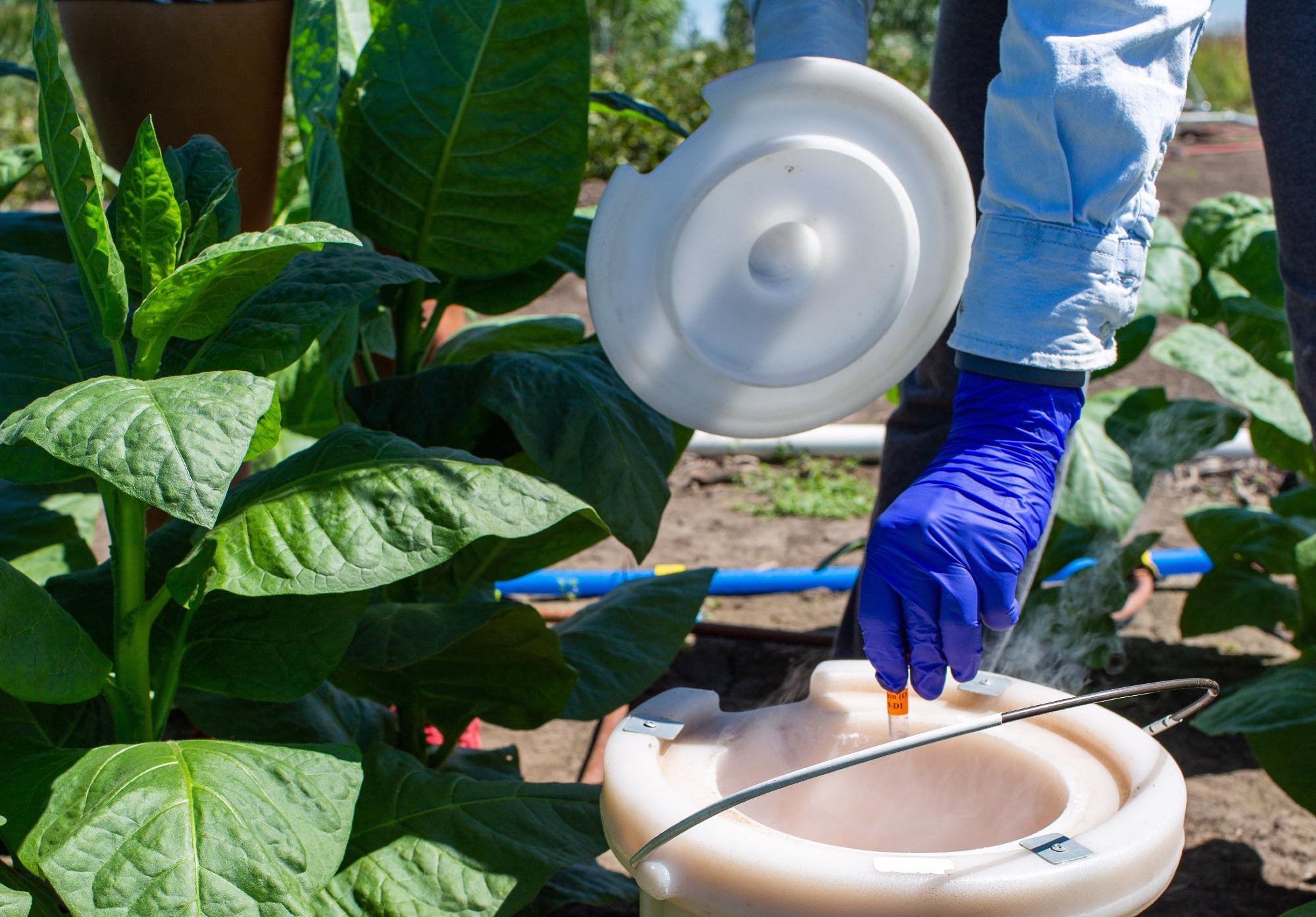To maintain pace with the expanding population, it is estimated that the global food supply will need to rise by 50-80% by 2050. Scientists from all over the world have been trying to figure out how to grow food crops in a sustainable way to fulfill this demand, and enhancing photosynthesis in plants holds a lot of promise for resolving these difficulties.
 Ursula Ruiz-Vera collecting samples from ictB field trial. Image Credit: Claire Benjamin/RIPE project.
Ursula Ruiz-Vera collecting samples from ictB field trial. Image Credit: Claire Benjamin/RIPE project.
A team of Illinois scientists examined the potential for higher plant production and intrinsic water-use efficiency by overexpressing inorganic carbon transporter B (ictB) in field-grown tobacco in a new study published in the Journal of Experimental Botany. Their findings, however, revealed no significant differences between wild-type and ictB-expressing tobacco lines produced in the field.
Christine Raines, the paper’s corresponding author, collaborated with University of Essex scholars Kenny Brown, Chidi Afamefule, Hussein Gherli, Andrew Simkin, and Tracy Lawson on this work. The ictB single construct was inserted in the tobacco cv. Samsun backdrop to create the tobacco transformants. The Energy Farm in Illinois was used to produce tobacco transformants and wild-type tobacco plants.
“Our results indicated that ictB overexpression may only benefit crops grown in controlled environments, such as greenhouses,” said Ursula Ruiz-Vera, a former postdoctoral researcher at the University of Illinois Urbana-Champaign.
Ruiz-Vera led this study for a research project called Realizing Increased Photosynthetic Efficiency (RIPE).
If the benefits of the ictB overexpression can only be seen in plants grown in controlled environments, it is worth a deeper exploration of this method under these conditions which can benefit crops that use environments like greenhouses, like vegetable crops. However, this method may not be the most efficient way to increase food production under field conditions.”
Ruiz-Vera, Senior Scientist, Control Environment Plant Physiologist, Bayer Crop Science
RIPE, which is headed by Illinois, is working to improve photosynthesis in crops to make them more productive. The Bill & Melinda Gates Foundation, the Foundation for Food & Agriculture Research, and the UK Foreign, Commonwealth & Development Office all sponsor RIPE.
C3 and C4 photosynthesis are the two main forms of photosynthesis found in plants. The distinction between these two is that C4 plants use a carbon concentration mechanism (CCM) to raise CO2 levels near the enzyme Rubisco. C4 plants use water and nitrogen more efficiently because of this CCM.
Most important human food crops, on the other hand, use the less efficient C3 photosynthetic pathway, leading to the efforts to develop C3 crops. Overexpression of the ictB gene has been indicated in several research to boost photosynthetic efficiency in C3 plants.
Tobacco plants have been used extensively in RIPE’s testing of photosynthetic enhancements because they are a simple solid evidence crop. Since tobacco is simple to genetically convert due to its ability to generate huge amounts of seed, shortening testing cycles, it is simpler to transmit beneficial genetic features to food crops like cowpea, cassava, and soybean.
Based on current research that showed ictB tobacco transformants boosted photosynthetic efficiency and biomass without reducing water-use efficiency, the team assessed four tobacco ictB transformants for photosynthetic performance in field-based circumstances compared to wild-type.
“Most of the previous studies have been performed in controlled conditions and it isn’t clear if these improvements in plant productivity could be translated to crops in the field,” said Liana Acevedo-Siaca, who co-led this study at Illinois during her time as a postdoctoral researcher. “In this experiment, we wanted to grow ictB tobacco plants in the field to evaluate if these transgenic plants have a higher photosynthetic efficiency than wild-type under field conditions.”
In contrast to earlier research that claimed otherwise, their data suggested that the transformants could not perform well than wild-type on photosynthesis, biomass, or leaf composition-related traits. However, prior studies have demonstrated considerable gains in biomass output with ictB overexpression, thus there is still hope that ictB can help boost agricultural yields.
More research is needed to completely understand the gene’s function and the environmental factors in which it improves crop production the most, assisting in meeting the world’s growing food needs.
Although previous results showed benefits in greenhouses and controlled environments for ictB transformants, there is a bright side as well. As we look to increase food production sustainably, agriculture in greenhouses and vertical farming may benefit from ictB overexpression.”
Liana Acevedo-Siaca, Associate Scientist, Global Wheat Program, International Maize and Wheat Improvement Center
Source:
Journal reference:
Ruiz-Vera, U. M., et al. (2022) Field-grown ictB tobacco transformants show no difference in photosynthetic efficiency for biomass relative to wildtype. Journal of Experimental Botany. doi.org/10.1093/jxb/erac193.